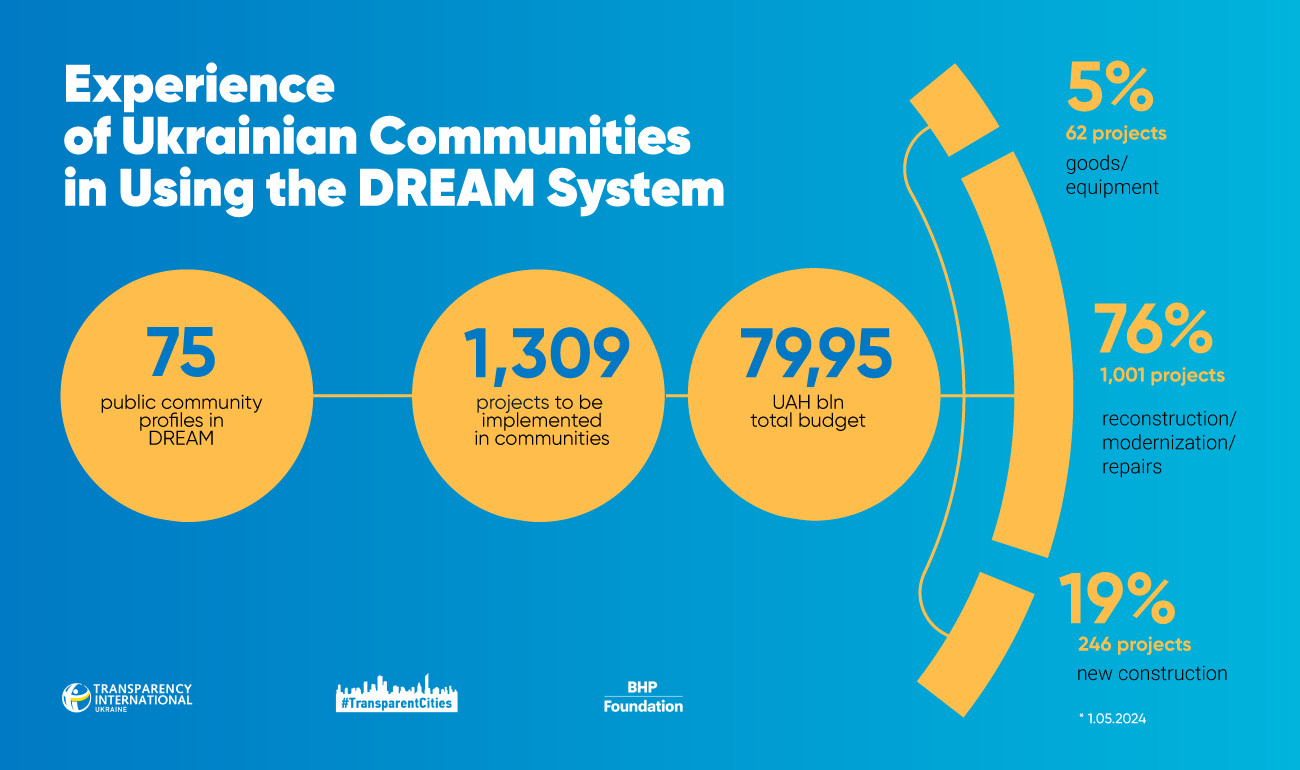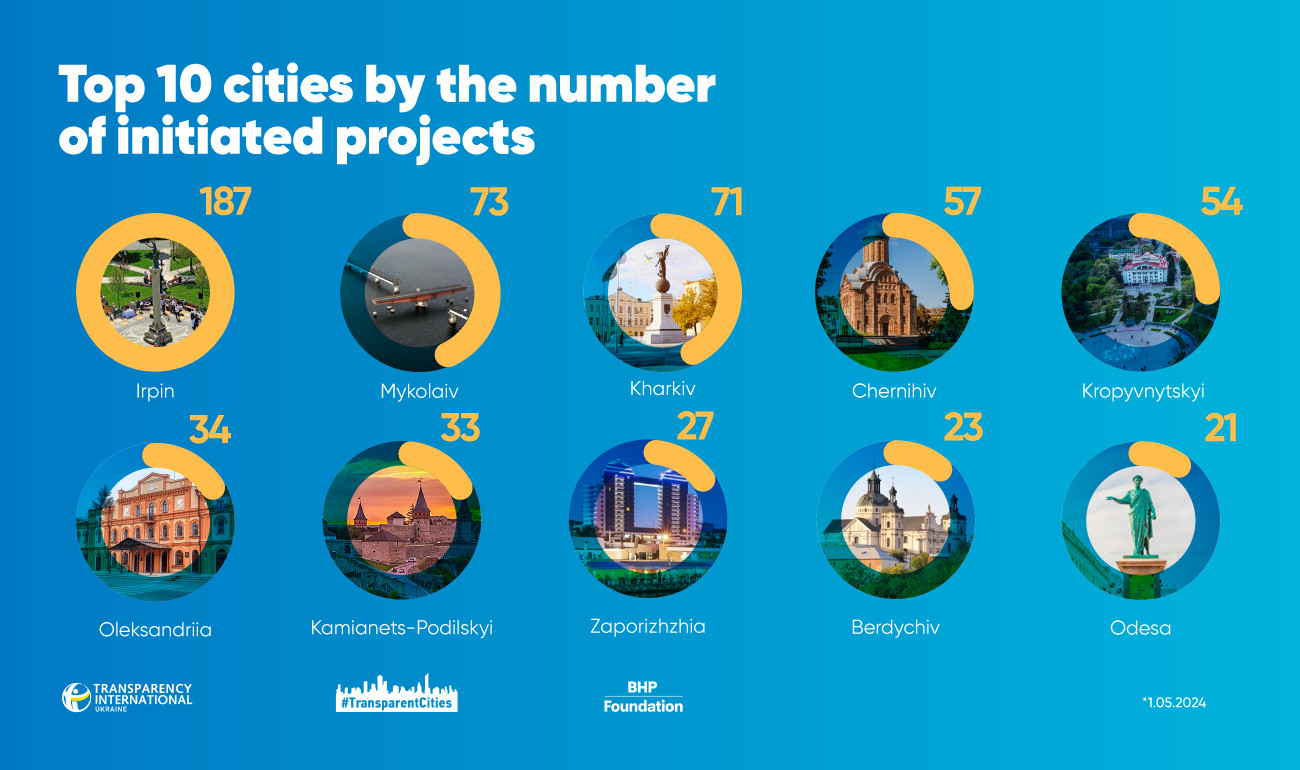Most of the Ukrainian cities studied by TI Ukraine have already begun to use the DREAM system. As of May, more than 1,300 projects with a total budget of about UAH 80 billion are planned to be implemented in these communities.
The Transparent Cities program (Transparency International Ukraine) explored the use of the DREAM digital ecosystem to accountably manage recovery at the local level. Analysts have identified strengths and growth areas of the tool to enhance its effectiveness, transparency, and accountability in reconstruction and recovery.
The DREAM system is an important tool for high-quality management of both resources, in particular financial ones, and projects. The system allows monitoring reconstruction projects and tracking the results of recovery, which therefore contributes to reducing the corruption component and increasing transparency. TI Ukraine believes that the use of the system should become mandatory for the public sector, so it was essential for the Transparent Cities program to find out how the DREAM system was used at the local level, what benefits it gave, and what prevents local self-government bodies from using this tool.
The team sent a questionnaire to 80 municipalities that participated in the 2023 transparency study of city councils. It also analyzed the existing public profiles of communities in the system, the orders of mayors on the appointment of a responsible person/persons on the use of the DREAM system, and obtained comments from the developers.
As of May 1, 2024, 67 of the 80 cities under study used the system, that is, they had initiated projects. In total, public profiles of 75 communities were available in the DREAM system. The statistical data provided in these profiles indicate that 1,309 projects with a total budget of UAH 79.95 billion are planned to be implemented in the territories of these communities. Among them, the nature of 76% of projects is designated as reconstruction / modernization / repairs; 19% cover new construction; and 5% account for goods / equipment.

The highest number of projects is to be implemented in the territories of the Irpin, Kharkiv, and Mykolaiv communities. Chernihiv, Kropyvnytskyi, Zaporizhzhia, Oleksandriia, Kamianets-Podilskyi, Sumy, and Chernivtsi communities are among the top ten by the number of projects.
Among the 1,309 projects that are planned to be implemented in communities, cities have initiated 73% of the projects; other administrations, state-owned enterprises, institutions, and organizations have initiated 13%. In 14% of projects, the initiators have not yet been identified.
Irpin, Kharkiv, and Mykolaiv show the highest number of initiated projects.

By May 1, 2024, 58 of the 80 cities studied had identified a person/persons responsible for using the DREAM system.
Typically, a representative of a unit related to economic development, investment, housing and municipal services, or urban development was appointed as the responsible person. Three regional centers made a peculiar decision. In Zhytomyr, a representative of the Department of Emergencies and Civil Protection of the Population was appointed; in Poltava, it was the Deputy Director of the municipal organization City Development Institute. In 2023, Vinnytsia City Council established a separate Department of Reconstruction and Development and entrusted this structural unit with the powers of the main DREAM system user.
In their responses, cities mentioned many positive aspects of the DREAM ecosystem. In particular, this tool provides a unique opportunity to systematize projects and makes it convenient for potential investors and partners to access information. The biggest advantage is that the system provides transparency and accountability of the recovery process and allows the public to track all stages of projects—from planning to completion.
The main challenges cities faced when using the DREAM system included the fact that it was often updated and that there were difficulties in entering project information. Some municipalities mentioned problems working with the interface, the inability to delete certain information, and the lack of stability in the system.
The DREAM team confirmed that the nuances in the work were indeed observed, especially at the initial stages, but most of them had already been eliminated, and they were working on other shortcomings.
According to TI Ukraine, local self-government bodies are not doing enough to tell city residents about the DREAM system and its capabilities. Only Irpin City Council provided for a separate Reconstruction (DREAM) section on the page of its official website. The results of the analysis of news stories from 80 official websites of city councils showed that as of the end of April 2024, only 18 city councils had shared materials either about the DREAM system in general or about their work with it. Even the cities that popularized the DREAM system did not share links to their public profiles, for the most part.
The Transparent Cities program encourages cities to promote the system, educate their residents about its full potential, and encourage monitoring of projects and their funding.
To make the public aware of the DREAM system as soon as possible, we recommend that cities:
- appoint a responsible person for the use of the system (unless they have done it) and publish a document on this appointment on the official website;
- integrate community profile widgets, project widgets in the official website of the city council;
- decide on the frequency of publishing news about working with the DREAM system, covering this activity on the website and on the social networks of the city council.
In order for the profiles to turn into quality business cards of communities and attract the attention of potential investors, the program recommends:
- adding a meaningful description of the community, key information about it (preferably in two languages);
- entering all the necessary information for the profile cover and selecting photos of proper quality and content;
- specifying a contact person responsible for working with the DREAM system;
- adding official documents that will give donors and partners a clear idea of the potential and features of the community—an investment passport of the territorial community/city, a strategy for the development of the territorial community/city, a strategic plan for the development of the city, a charter of the territorial community, and others (preferably in two languages);
- monitoring that the filenames of documents have a meaning
- when entering information about the project, carefully considering the indication of the geography (the territory of the region, the territory of the community, the territory of the settlement), using the guide for working with the electronic cabinet of the user of the DREAM ecosystem.
The DREAM system is an essential tool for successful recovery. It should become mandatory for use in all cities. It not only allows seeing all the information about reconstruction projects, but also allows anyone anywhere to control each stage of these projects. Thus, the public will be able to influence the construction processes in their cities, and local governments will have a chance to demonstrate transparency in management and attract additional funding.